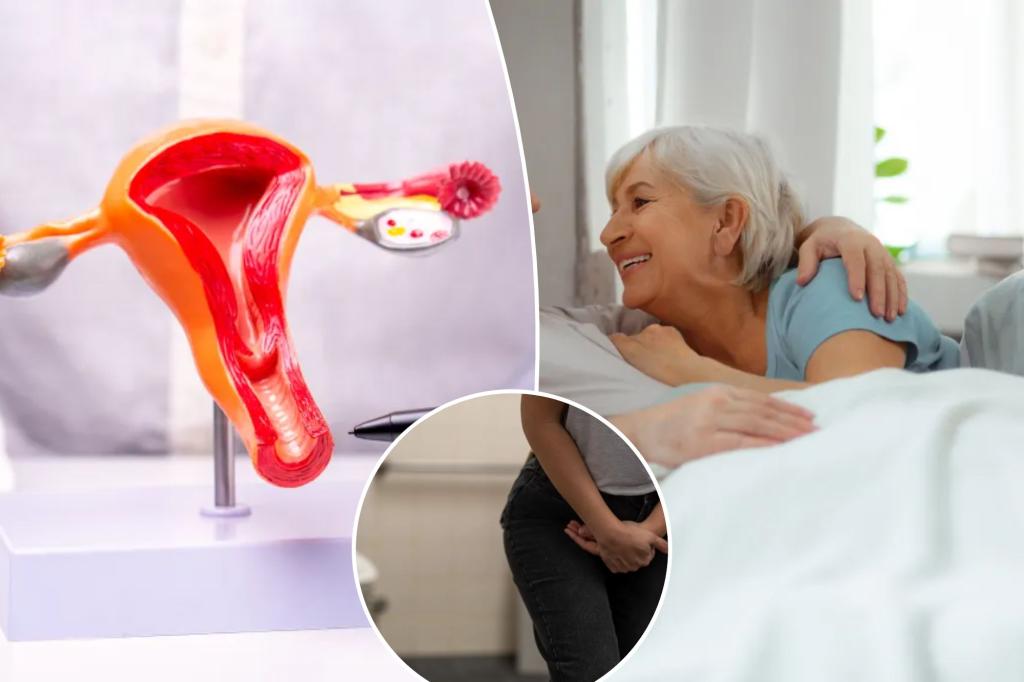Hot flashes, night sweats and mood swings often steal the spotlight during menopause, but “the change” also stirs up issues below the belt.
“Estrogen is our superpower, and during perimenopause and menopause, the erratic production of this important hormone has a negative impact on the vulva and vagina,” explained Dr. Sherry Ross, an author and board-certified OB/GYN.
The Post spoke to two experts to break down just what menopause can do — ahem — down there, from thinning to dryness to lady bits that look entirely different than they did before.
What is menopause?
Menopause playing out in three distinct acts. The first stage, perimenopause, typically begins in the late 40s and can last several years. It’s characterized by irregular periods, fluctuating hormones, and the onset of many familiar symptoms.
The second stage, menopause, is reached after 12 consecutive months without a period, while the third, postmenopause, begins after a full year without a period and lasts for the rest of a woman’s life.
“During perimenopause, the annoying genital symptoms begin, but they aren’t as disruptive until menopause officially begins,” Ross said.
Don’t tell Cardi B: The WAP is gone
“The primary cause of genital changes during menopause is estrogen decline,” said Dr. Anat Sapan, a board-certified OB/GYN and menopause expert.
During this transition, estrogen levels can plummet by as much as 90%, leaving a host of unpleasant side effects in its wake.
“The labia minora often become thin and may appear to shrink or, in some cases, seem to disappear entirely.”
Dr. Anat Sapan
“With low or nonexistent estrogen, there is less blood flow to the vulva and vaginal tissue, causing dryness, shrinking of the vaginal opening, and less natural lubrication causing pain, itching, irritation, burning and painful sexual penetration,” Ross said.
The vaginal tissue also becomes thin and less elastic, which further contributes to discomfort with everyday activities and negatively impacts sexual health.
Not lookin’ so snatched
They say it’s what’s on the inside that counts — but the outside of the vulva undergoes some changes, too.
“Menopause distinctly alters vulvar appearance,” Sapan said. “The labia minora often become thin and may appear to shrink or, in some cases, seem to disappear entirely as tissue volume diminishes with estrogen loss.”
Fat distribution also shifts, which can create the appearance of sagging — in fact, some women are now going as far as to have filler injected into their labia to “puff” them up.
“The clitoral hood may retract, sometimes exposing the glans clitoris more prominently,” she added.
Additionally, pubic hair becomes sparser and grayer.
These symptoms, often bundled under the term genitourinary syndrome of menopause (GSM), affect anywhere from 50% to 70% of postmenopausal women, according to Sapan.
Microbiome mayhem and an unbalanced va-jay-jay
As if the physical changes weren’t enough, menopause also disrupts the vaginal microbiome.
“Balance in life and balance in the vagina go hand in hand,” Ross said. “The vagina is normally acidic. This sounds scary, yet it is the preferred pH balance and perfect for the many protective organisms to live happily while protecting the vagina from infections.”
But as estrogen levels decline during menopause, the vaginal microbiome takes a hit, and the amount of protective bacteria Lactobacillus diminishes, Sapan explained. This shift triggers a change in vaginal pH, moving from a healthy acidic range to a more alkaline one.
This new environment is more inviting to harmful pathogens, which Ross said can increase a woman’s risk of yeast and bacterial infections.
You may pee yourself
Menopause also takes a toll on your pelvic floor, which plays a crucial role in supporting the uterus, bladder and bowels.
When menopause strikes, hormonal changes and aging can weaken them, leading to serious issues with their strength and function.
“The loss of estrogen during menopause negatively affects the healthy blood flow and lubrication to the muscles and tissues of the pelvic floor,” Ross said.
“As a result, there is a weakening of the pelvic floor muscles leading to urinary incontinence, bladder dysfunction, pelvic organ prolapses, poor pelvic floor strength and sexual problems,” she added.
Studies indicate that between 25% and 50% of postmenopausal women deal with some form of urinary incontinence, or involuntary leakage. According to Ross, this common issue often leads many women to rely on protective pads, a solution that can inadvertently increase the risk of vulvar dryness and irritation.
Now what?
While many of the changes to the physical appearance of your vulva can’t be fully avoided, Ross says they can be minimized.
“Healthy feminine hygiene care — proper cleaning, hydrating and moisturizing — from an early age can protect the delicate skin of the vulva and vagina from dryness, itching, irritation, infection, breakout, and other causes of pre-mature aging,” she said.
For issues like thinning tissue and dryness, Sapan recommends vaginal moisturizers and lubricants for symptomatic relief.
“Prescription remedies include a non-hormonal prescription, Osphena, and oral or vaginal estrogen creams, tablets and Estring, which have been proven for best results,” Ross said.
For those who want to avoid a prescription, Sapan suggests advanced options like radiofrequency therapy or fractional CO2 laser treatments to stimulate collagen production and rejuvenate tissue.
If you’re experiencing pain during penetration, Ross said vaginal dilators could be useful for stretching the vaginal opening.
To help balance your vaginal pH, Sapan suggested trying topical estrogen therapy, which can help support the regrowth of Lactobacillus bacteria.
“Probiotic supplementation containing specific Lactobacillus strains may complement these approaches by directly reintroducing beneficial bacteria to help normalize the vaginal environment,” she noted.
If you’re dealing with pelvic floor changes, physical therapy can help improve muscle coordination and strength.
“While Kegel exercises are commonly recommended, professional assessment is valuable as some women develop hypertonic (too tight) rather than hypotonic (too loose) pelvic floor dysfunction, requiring different therapeutic approaches,” Sapan said.
Read the full article here

